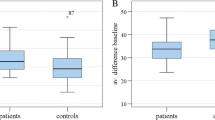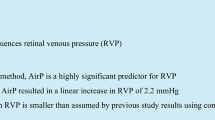Abstract
Purpose
To investigate the autoregulative response of large retinal vessels to artificial reduction of perfusion pressure.
Methods
The diameters of a venous and an arterial segment (each approx.1.5 mm in length) in one eye of each of 13 healthy volunteers (age 54.5±18 years) were measured continuously using the Retinal Vessel Analyzer (Imedos, Weimar, Germany). The intraocular pressure (IOP; mean before examination 13.7±2.9 mmHg) was increased by 21.2±3.5 mmHg by means of a suction cup in order to produce a temporary reduction of the retinal perfusion pressure. The RVA measurements were taken for 2 min without artificial intervention (baseline), for 100 s during IOP elevation, and for up to 10 min after removal of the suction cup.
Results
A significant response of arterial and venous diameters to the provocation was found (P<0.02, ANOVA). The arterial and venous responses were opposite: Whereas the artificially elevated IOP increased the arterial diameter by +1.9±4.5%, the venous vessel diameter decreased by −2.6±3.5% (P<0.02, Mann–Whitney U-test). After normalization of the IOP the arterial diameter fell slightly below the baseline value, while the veins underwent temporary dilation by +5.9±3.3% (P<0.001). The mean systemic blood pressure did not change significantly during the investigation.
Conclusion
Retinal arteries and veins of healthy volunteers exhibited opposite autoregulative behavior in response to perfusion pressure changes. This is believed to be due to the different regulative functions of arteries and veins.




Similar content being viewed by others
References
Bayliss WM (1902) On the local reactions of the arterial wall to changes of internal pressure. J Phys 28:220–231
Bill A, Sperber GO (1990) Control of retinal and choroidal blood flow. Eye 4:319–325
Blum M, Bachmann K, Wintzer D, Riemer T, Vilser W, Strobel J(1999) Noninvasive measurement of the Bayliss effect in retinal autoregulation. Graefes Arch Clin Exp Ophthalmol 237:296–300
Brazitikos PD, Pournaras CJ, Tsacopoulos M, Munoz JL (1992) [Metabolic factors of vasomotor regulation of the inner retina] Klin Monatsbl Augenheilkd 200:502–503
Brody S, Erb C, Veit R, Rau H (1999) Intraocular pressure changes: the influence of psychological stress and the Valsalva maneuver. Biol Psychol 51:43–57
Cheng MA, Todorov A, Tempelhoff R, McHugh T, Crowder CM, Lauryssen C (2001) The effect of prone positioning on intraocular pressure in anesthetized patients. Anesthesiology 95:1351–1355
Collignon N, Dewe W, Guillaume S, Collignon-Brach J (1998) Ambulatory blood pressure monitoring in glaucoma patients. The nocturnal systolic dip and its relationship with disease progression. Int Ophthalmol 22:19–25
David R, Zangwill L, Briscoe D, Dagan M, Yagev R, Yassur Y (1992) Diurnal intraocular pressure variations: an analysis of 690 diurnal curves. Br J Ophthalmol 76:280–283
Delaey C, Van De Voorde J (2000) Regulatory mechanisms in the retinal and choroidal circulation. Ophthalmic Res 32:249–256
Dickerman RD, Smith GH, Langham-Roof L, McConathy WJ, East JW, Smith AB (1999) Intra-ocular pressure changes during maximal isometric contraction: does this reflect intra-cranial pressure or retinal venous pressure? Neurol Res 21:243–246
Findl O, Strenn K, Wolzt M, Menapace R, Vass C, Eichler HG, Schmetterer L (1997) Effects of changes in intraocular pressure on human ocular haemodynamics. Curr Eye Res 16:1024–1029
Funk RH (1997) Blood supply of the retina. Ophthalmic Res 29:320–325
Graham SL, Drance SM (1999) Nocturnal hypotension: role in glaucoma progression. Surv Ophthalmol 43 [Suppl 1]:10–16
Hafez AS, Bizzarro RL, Rivard M, Lesk MR (2003) Changes in optic nerve head blood flow after therapeutic intraocular pressure reduction in glaucoma patients and ocular hypertensives. Ophthalmology 110:201–210
Harris A, Ciulla TA, Chung HS, Martin B (1998) Regulation of retinal and optic nerve blood flow. Arch Ophthalmol 116:1491–1495
Hogan MJ, Feeney L (1963) The ultrastructure of the retinal blood vessels. 1. The large vessels. J Ultrastruct Res 9:10–28
Jandrasits K, Polak K, Luksch A, Stark B, Dorner GT, Eichler HG, Schmetterer L (2001) Effects of atropine and propranolol on retinal vessel diameters during isometric exercise. Ophthalmic Res 2001 33:185–190
LeMarr JD, Golding LA, Adler JG (1984) Intraocular pressure response to inversion. Am J Optom Physiol Opt 61:679–682
Linder BJ, Trick GL, Wolf ML (1988) Altering body position affects intraocular pressure and visual function.Invest Ophthalmol Vis Sci 29:1492–1497
Liu JH, Kripke DF, Hoffman RE, Twa MD, Loving RT, Rex KM, Gupta N, Weinreb RN (1998) Nocturnal elevation of intraocular pressure in young adults. Invest Ophthalmol Vis Sci 39:2707–2712
Meyer-Schwickerath R, Kleinwachter T, Firsching R, Papenfuss HD (1995) Central retinal venous outflow pressure. Graefes Arch Clin Exp Ophthalmol 233:783–788
Nagel E, Vilser W, Lanzl I (2001) Retinal vessel reaction to short-term IOP elevation in ocular hypertensive and glaucoma patients. Eur J Ophthalmol 11:338–344
Orgul S, Gugleta K, Flammer J (1999) Physiology of perfusion as it relates to the optic nerve head. Surv Ophthalmol 43 [Suppl 1]:17–26
Osusky R, Rohr P, Schotzau A, Flammer J (2000) Nocturnal dip in the optic nerve head perfusion. Jpn J Ophthalmol 44:128–131
Pillunat LE, Stodtmeister R (1991)Das Normaldruckglaukom—eine Mikrozirkulationsstörung. In: Stodtmeister R, Pillunat LE (eds) Mikrozirkulation in Gehirn und Sinnesorganen. Enke, Stuttgart, pp 124–143
Pillunat LE, Anderson DR, Knighton RW, Joos KM, Feuer WJ (1997) Autoregulation of human optic nerve head circulation in response to increased intraocular pressure. Exp Eye Res 64:737–744
Polak K, Dorner G, Kiss B, Polska E, Findl O, Rainer G, Eichler HG, Schmetterer L (2000) Evaluation of the Zeiss retinal vessel analyser. Br J Ophthalmol 84:1285–1290
Riva CE, Sinclair SH, Grunwald JE (1981) Autoregulation of retinal circulation in response to decrease of perfusion pressure. Invest Ophthalmol Vis Sci 21:34–38
Riva CE, Harino S, Shonat RD, Petrig BL (1991) Flicker evoked increase in optic nerve head blood flow in anaesthetised cats. Neurosci Lett 128:291–296
Riva CE, Cranstouwn SD, Petrig BL (1996) Effect of decreased ocular perfusion pressure on blood flow and flicker induced flow response in the cat optic nerve. Microvasc Res 52:258–269
Riva CE, Falsini B, Logean E (2001) Flicker-evoked response of human optic nerve head blood flow: luminance versus chromatic modulation. Invest Ophthalmol Vis Sci 42:756–762
Rosenblum WJ (1977) Pressure–flow relationship of single vessels and organs. In: Kaley G, Altura BM (eds) Microcirculation, vol 1. University Park Press, Baltimore, p 335
Schulte K, Wolf S, Arend O, Harris A, Henle C, Reim M (1996) Retinal hemodynamics during increased intraocular pressure. Ger J Ophthalmol 5:1–5
Stodtmeister R, Pillunat LE (1991) Das primäre Offenwinkelglaukom—eine Mikrozirkulationsstörung. In: Stodtmeister R, Pillunat LE (eds) Mikrozirkulation in Gehirn und Sinnesorganen. Enke, Stuttgart, pp 114–123
Toi VV, Riva CE (1995) Variations of blood flow at optic nerve head induced by sinusoidal flicker stimulation in cats. J Physiol 482:189–202
Ulrich C (1980) Klinik und Praxis der Ophthalmodynamometrie, Ophthalmodynamographie, Temporalisdynamographie. In: Abhandlungen aus dem Gebiete der Augenheilkunde, vol 46. VEB Georg Thieme Verlag, Leipzig
Vilser W, Nagel E, Fuhrmann G, Riemer T (2000) Retinale Gefäßanalyse—Neue Möglichkeiten zur Untersuchung von Netzhautgefäßen. In: Schmidt KG, Pillunat L (eds) Fortbildung Glaukom, vol 3: Funktionsdiagnostik und pathogenetische Konzepte. Enke/Thieme, Stuttgart, pp 73–91
Author information
Authors and Affiliations
Corresponding author
Rights and permissions
About this article
Cite this article
Nagel, E., Vilser, W. Autoregulative behavior of retinal arteries and veins during changes of perfusion pressure: a clinical study. Graefe's Arch Clin Exp Ophthalmol 242, 13–17 (2004). https://doi.org/10.1007/s00417-003-0663-3
Received:
Revised:
Accepted:
Published:
Issue Date:
DOI: https://doi.org/10.1007/s00417-003-0663-3




